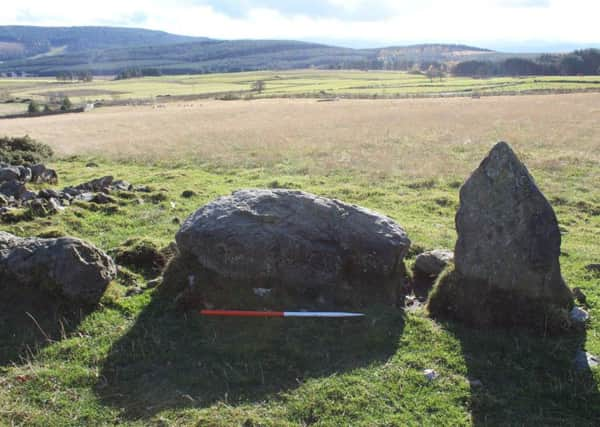Stone circle isn’t ancient, but it is justified – Martyn McLaughlin


The late Spike Milligan once said that when he died, he hoped to be laid to rest in a washing machine, for no other reason than to confuse the archaeologists of the future.
Those who make a living by combing through the detritus of the past in order to better understand who we are and where we come from deserve sympathy. It can be a gruelling, fruitless task, waged in all weathers.
Advertisement
Hide AdAdvertisement
Hide AdBut in a conservative discipline where context is everything, it is nice to see archaeologists can also see the funny side of things.
The defrocking of the Holmhead stone circle in Aberdeenshire, which until recently was believed to date back to the Bronze Age, shows how those who retrace the journey made by our descendants are prone to the odd misstep.
Only last month, Historic Environment Scotland and Aberdeenshire Council declared it to be an authentic prehistoric site. This week, a farmer who once worked the land on which is located disabused them of such notions. The stone circle, he revealed, could be traced only as far back as the era of Britpop and combat trousers.
As Neil Ackerman, the local authority’s historic environment records assistant, humbly pointed out on Twitter, the revelation is unlikely to grace his CV in future.
“If you are having an awkward day at work, at least you’re not that guy who identified a new prehistoric stone circle to the press that now turns out to be about 20 years old,” he wrote.
It is refreshing to see a professional freely admit to making an error and do so with such good humour. Mr Ackerman has been in his post for less than three years, but his candour means he can look forward to a bright future. As well as providing some levity, the misclassification has helped promote the north east’s established archeological treasures. Who among us would have known of Aberdeenshire’s unique bounty of recumbent stone circles were it not for the imposter in their midst?
In any case, who are we to judge what is real or fake, or to differentiate those creations that have meaning from the ones that are mere whimsy? For all that technology has aided research into our origins, the stone circles specked across Scotland and further afield remain shrouded in mystery, with the purpose of their creation, the manner of their construction, and the choice of their location as elusive as ever.
There are countless competing theories which may offer fragmentary answers, but my favourite proposition is that the people who erected them did so simply to cause a bit of good-natured mischief. If that is the case – and there is no good reason why not – then our Aberdeenshire farmer was keeping this noble tradition alive, albeit inadvertently (he reportedly said it wasn’t designed “to con anyone”, but simply to be a “garden feature”). Holmhead may be the punchline to a joke that started with Callinish or Stennesh.
Advertisement
Hide AdAdvertisement
Hide AdThe search for definitive truths and the contested hypotheses surrounding our stone circles is made to look foolish when you consider the reverence afforded to the pretenders.
Take the Druid’s Temple in the Yorkshire village of Ilton, for example. A cluster of stones closely resembling Stonehenge, its eerie formation has given rise to scurrilous tales of satanic worship and archaic rituals.
The reality is that it was built in the early 19th century at the behest of William Danby, a wealthy landowner who wished to alleviate local unemployment and have a little fun into the bargain. He paid workers a shilling a day to prop up the 10ft-high stones.
Nowadays, a modest annual footfall of tourists give thanks to his eccentric vision, with WRI coach parties happily mingling with new age pagans.
Closer to home, there is the wonder that is the Sighthill Megalith, which for years held pride of place at the heart of a once-bustling Glasgow housing scheme. Its stones, quarried in Kilsyth, were lowered into place by a Royal Navy Sea King helicopter as recently as 1979.
Just as Thatcherism was about to sink its teeth into Scotland, the circle was created as part of a marvellously Orwellian-sounding initiative known as the Special Temporary Employment Programme.
Overseeing the venture was Duncan Lunan, a science fiction author and astronomer. “You would have thought that unless the glaciers came back, nothing could harm it,” he went on to reflect.
Sadly, Mr Lunan did not anticipate urban Scotland’s rapacious appetite for regeneration. The stones, a place of worship for druids and respite for Sighthill’s residents, were removed to make way for a quarter-of-a-billion-pound masterplan, but having been championed by the likes of Alasdair Gray, they are due to be installed at a new site later this year. The city would not allow otherwise.
Advertisement
Hide AdAdvertisement
Hide AdNeither of these sites would be accepted as prehistoric marvels, but they are marvels all the same – treasured and respected by the communities around them and the tourists who pass through.
That is in large part due to the way they openly invite interpretation and an emotional response. Unlike, say, Piltdown Man, a sophisticated act of fraud which set out to deliberately deceive, they have been carved out of nothing with innocence. They provoke awe, not scepticism.
In time, the same will hopefully be said of Aberdeenshire’s latest stone circle. It’s creator clearly had a great love of Scotland’s ancient history, and his painstaking homage deserves to become an attraction in its own right. If you visit in the right state of mind, in search of intrigue and amazement, the chances are you will find it.
